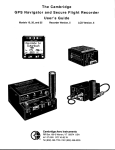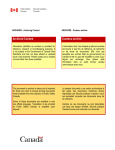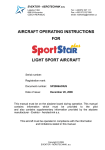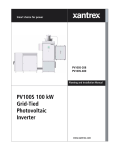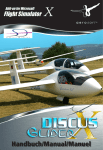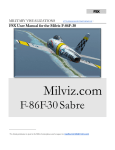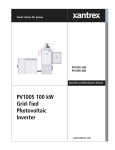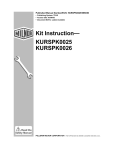Download Nemeth Designs/Milviz AW109 FSX Operation Manual
Transcript
Operations Manual Nemeth Designs/MILVIZ AgustaWestland AW109 for FSX 2 Operations Manual CONTENTS GENERAL Overview Dimensions and performance Dimensions Overview Page 3 Page 3 Page 4 SYSTEM DESCRIPTION Powerplant Fuel system Flight controls/Hydraulic systems Electrical system AC system Page 5 Page 6 Page 7 Page 8 Page 9 PANELS Panel Overview Panel Medevac Panel VIP Autopilot Center console Overhead panel Middle Panel Collective section Page 10 Page 11/12 Page 13/14 Page 15 Page 16 Page 17 Page 18 Page 19 CHECKLISTS Checklist prestart Normal Start Engine 1 start Engine 2 start Quick engine start/systems check Taxiing Hover Take off Rolling start In Flight Shutdown Post flight check Acknowledgements Support Page 20 Page 21 Page 22 Page 23 Page 24 Page 25 Page 26 Page 27 Page 28 Page 29 Page 30 Page 31 Page 32 Nemeth Designs/MILVIZ AgustaWestland AW109 for FSX Operations Manual I. GENERAL 1. Overview The A109E is a high-speed, high-performance, multi-purpose helicopter powered by two Pratt & Whitney Canada PW206C engines, with a four-bladed fully articulated main rotor system, two-bladed tail rotor and a retractable tricycle-type landing gear. The airframe consists of two major assemblies: the forward fuselage and the aft fuselage (tail boom). The forward fuselage comprises of the nose section, the cabin and the rear section. The nose section includes an upper compartment for the electrical and electronic equipment, and a lower compartment which accommodates the hydraulic system accumulators, the nose landing gear and the other hydraulic components. The cabin includes the crew compartment (cockpit) and the passenger compartment. Seating is provided for the pilot (right side) and a passenger (or copilot) on the left side in the cockpit, and up to six passengers in the relevant rear compartment. The rear section accommodates the fuel tanks, the main landing gear compartments, the baggage compartment and the electrical and electronic equipment compartment. The upper deck, located above and aft of the cabin area, accommodates the hydraulic system reservoirs and filter goups, the main transmission, oil coolers and engines. The tail boom is bolted to the forward fuselage and supports the tail rotor and the relevant drive system. The tail boom includes elevators, vertical upper and lower fins, tail skid and the tail cone. 2. Dimensions and performance Crew: Capacity: Length: Height: Width: Empty weight: Max takeoff weight: Max airspeed: Range: Service ceiling: Powerplant: 1 (2) pilot 4-7 passengers 13.1 m / 42.88 ft 3.5 m / 11.48 ft 7.8 m / 25.59 ft 1569 kg / 3.461 lb 2849 kg / 6.283 lb 285 km/h / 154 knots 964 km / 521 nm 5974 m / 19.600 feet Pratt & Whitney Canada PW206C engines 567 hp 3 Nemeth Designs/MILVIZ AgustaWestland AW109 for FSX Operations Manual Dimensions overview 4 Nemeth Designs/MILVIZ AgustaWestland AW109 for FSX Operations Manual II. SYSTEM DESCRIPTIONS 1. Power plant The A109E is powered by two Pratt & Whithey Canada PW206C engines. The PW206C engine is a lightweight, free turbine, turboshaft engine incorporating a single-stage centrifugal compressor driven by a single stage compressor turbine. Metered fuel is sprayed into the reservoir flow annular combustion chamber through twelve (12) individual fuel nozzles mounted around the gas generator case. A single channel, Fully Authority Digital Electronic Control (FADEC) with a mechanical backup (FMM ″FUEL MANAGEMENT MODULE″) ensures accurate control of the engine output speed and fast response changes in power demand. The PW206C cosists of two modules: − − Turbomachinery module Reduction gearbox module The turbomachinery module comprises the cold section and the hot section, while the reduction gearbox provides to reduce power turbine speed to one suitable for rotorcraft transmission operation. The engine oil system is subdivided into two independent circuits, each connected to the respective engine. The engine oil system is of the dry-sump type and is supplied from an engine internal tank (one for each engine). Lubrication of different engine components is assured by a pump assembly, composed of a pressure pump and two scavenge pumps, driven by the accessory gearbox, and a pressure circuit filter. An electrical signal supplies by no.1 or no.2 FADEC to DAU which sends signal to EDU1 that displays #1 OIL PRES and #2 OIL PRES caution legends. Two magnetic chip detectors, one located in the bottom of the accessory gearbox, the other in the scavenge pumps outlet, are electrically connected with EEC and DAU which sends signal to EDU1 that displays #1 OIL CHIPS and #2 OIL CHIPS caution legends. The operation of the oil system is fully automatic and therefore no action is required from the pilot except for monitoring the system through EDUs display. 5 Nemeth Designs/MILVIZ AgustaWestland AW109 for FSX Operations Manual 2. Fuel system The fuel system (figure 7-9) consists of the following sub -systems: − − − Storage system Distribution system Indication system The storage system consists of two main tanks and one main rear tank. Each forward tank supplies fuel to the associated engine. The distribution system consists of two identical independent circuits, each connected to associated engine. Each circuit comprises one fuel pump, a filter assembly, a shut off valve, a pressure transmitter and a differential pressure switch. A crossfeed valve allows the fuel to supply both engines from only one tank. The indicating system comprises the pressure indicating and fuel quantity indicating system and the fuel caution circuit. 6 Nemeth Designs/MILVIZ AgustaWestland AW109 for FSX Operations Manual 3. Flight controls The flight control systems provide the the correct control responses when the pilot makes control selections, giving him positive control of the attitude, speed and altitude of the helicopter. The A109E incorporates conventional helicopter flight controls: collective, cyclic and antitorque operated by cockpit controls: collective pitch lever, cyclic stick and tail rotor pedals. A mixing unit in the collective/cyclic control systems integrates the control inputs from both systems and provides a common output to the collective/cyclic actuators. 4. Hydraulic system Two independent systems supply the power to operate the flight control system and are used to provide the hydraulic power for operation of the main rotor servo actuators (both systems) and the tail rotor servo actuator (no.1 system only). In addition the no.2 system is used to provide the hydraulic power to the utility hydraulic system, necessary for operation of the landing gear and brakes. The hydraulic power consists of the no.1, no.2 and utility subsystems. The no.1 system system, which operates at a maximum pressure of 1550 psi, consists of a suction circuit, a pressure circuit, a return circuit and a bypass circuit. The hydraulic fluid is contained in the reservoir located on the right side of the cabin roof. The fluid is sucked by a pump, driven by main transmission, and is supplied to the servo actuators through the filter group and the accumulator. The system is controlled by the hydraulic control panel, located on the front console, operated by the pilot. A ground test fitting is provided, pressure monitoring circuit and a low pressure monitoring circuit. The no.1 system supplies the main rotor servo actuators and the tail rotor servo actuators. The no.2 system is similar to no.1 system. It supplies the main rotor servo actuators and the utility hydraulic system. The utility system receives the power pressure from no.2 hydraulic system and supplies the pressure to operate the landing gear, wheel brakes, rotor brake and nose gear centering lock. There are two sources of pressure energy supplied by this system: MAIN (NORMAL) to provide energy to operate landing gear actuators, landing gear uplocks, nose gear centering lock, wheel brakes (toe brakes) and wheel brakes (park selector). EMERGENCY: to provide energy to operate landing gear uplocks (unlocks), landing gear actuators (lower and lock), wheel brakes (park selector operation) and nose gear centering lock. 7 Nemeth Designs/MILVIZ AgustaWestland AW109 for FSX Operations Manual 5. Electrical system The electrical system is powered by single wire circuit with common ground return through the helicopter structure. The helicopter power supplies are: − − − 28 V dc 115 V ac 400 hz single phase 26 V ac 400 Hz single phase Two generators, a battery and, for ground handling, an external power receptacle, are the dc power main sources. Two static inverters, powered by dc voltage, are the ac sources. Both dc and ac powers are distributed through a bus bar system and operated by control switches located on the overhead console. The electrical system is interfaced with the IDS for voltage, current, advisory, caution and warning indications. DC System The dc electrical system is a 28 V direct current single conductor system, using the helicopter structure as a negative ground. The main components of the systems are two starter generators, two dc control boxes, battery, external power receptacle and one dc relay box. The helicopter is equipped with a 24 V, 27 or 22 Ah or with a 25.2 V, 28 Ah nickel-cadmium battery located in the nose compartment. A temperature switch, inside of the battery and connected to the IDS, detects the internal temperature of the battery, giving a BATT HOT warning message on the EDU 1 in case of battery overtemperature. The helicopter is provided with an external power receptacle on the rear right side of the fuselage. A microswitch, activated by the receptacle door, gives the EXT PWR ON advisory message on the EDU 1 when the door is in the open condition. Two starter-generators, installed each on the proper engine reduction gear-box, provide engine start when operated as an electric starter motor; after the engine start, the started generator, driven by the engine, reverts into a dc generator providing the necessary 28 V dc power. 8 Nemeth Designs/MILVIZ AgustaWestland AW109 for FSX Operations Manual AC system The alternate power is supplied by two 250 VA single phase static inverters via two sensor relays. The inverters require 28 V dc power input suppied by the dc main bus no.1, through the INV 1 circuit breaker and INV 1 ON/OFF switch, and the dc main bus no.2, through the INV 2 circuit braker and INV 2 ON/OFF switch. The circuit breakers and control switches are located on the overhead console. Each inverter supplies 115 V ac and 26 V ac to its own 115 V ac and 26 V ac distribution busses to which the helicopter ac loads are connected. In the event of an inverter failure, the relative sensing relay deenergizes, connecting the failed inverter busses to the other operating inverter. 9 Nemeth Designs/MILVIZ AgustaWestland AW109 for FSX Operations Manual III. PANELS Overview 10 Nemeth Designs/MILVIZ AgustaWestland AW109 for FSX 11 Operations Manual 1. MAIN PANEL Medevac 1. Transponder radio a) ON/OFF knob b) Frequency adjust knobs c) Frequency swap 2. NAV 2 radio a) ON/OFF knob b) Frequency adjust knobs c) Frequency swap 2. NAV 2 radio a) ON/OFF knob b) Frequency adjust knob c) Frequency swap 3. COM 2 radio a) ON/OFF knob b) Frequency adjust knobs c) Frequency swap 4. GPS a) COM frequency select for adjust b) NAV frequency select for adjust c) COM frequency swap button d) NAV frequency swap buttone) Frequency adjust knobs (mouse wheel) and COM/NAV select (left click) f) NRST button Nemeth Designs/MILVIZ AgustaWestland AW109 for FSX g) OBS button h) MSG button i) FLP button j) TERR button k) PROC button l) RNG button m) DTO button n) MENU button o) CLR button p) ENTER button r) Group/page adjust knobs (mouse wheel) and CURSOR (left click) s) ON/OFF 5. COM 1 radio a) ON/OFF knob b) Frequency adjust knob c) Frequency swap 6. NAV 1 radio a) ON/OFF knob b) Frequency adjust knob c) Frequency swap 7. ADF radio a) ON/OFF knob 12 Operations Manual b) Frequency adjust knob c) Frequency swap 8. MASTER CAUTION Annunciator 9. MASTER WARNING Annunciator 10. Airspeed a) IAS bug set b) IAS gauge test 11. Attitude a) Attitude cage button 12. Altimeter a) Altimeter reference pressure adjust knob 13. Verical speed a) VS bug set 14. Audio panel 15. HSI 2 a) Show MAP in ARC mode b) NAV bearing needle source select c) Course adjust knob d) HSI/CDI needle source select e) ARC/HSI mode f)-g) Zoom in/out h) ADF bearing needle source select i) Heading bug adjust 16. EDU 1 display a) ON/OFF button b) Message scroll button c) MENU d) AUX mode e) MAIN mode f) TEST 17. EDU 2 display a) ON/OFF button b) Message scroll c) MENU d) START mode e) CRUISE mode f) OEI mode g) TEST 18 HSI 1 a) Show MAP in ARC mode b) NAV bearing needle source select c) Course adjust knob d) HSI/CDI needle source select e) ARC/HSI mode f)-g) Zoom in/out h) ADF bearing needle source select i) Heading bug adjust 19. Chronometer a) Stopwatch reset button b) Mode select button c) Start/stop button 20. DME a) Source select/OFF knob 21. Backup attitude 22. Autopilot Nemeth Designs/MILVIZ AgustaWestland AW109 for FSX 13 Operations Manual VIP Transport 1. GPS a) COM frequency select for adjust b) NAV frequency select for adjust c) COM frequency swap button d) NAV frequency swap button e) Frequency adjust knobs (mouse wheel) and COM/NAV select (left click) f) NRST button g) OBS button h) MSG button i) FLP button j) TERR button k) PROC button l) RNG button m) DTO button n) MENU button o) CLR button p) ENTER button r) Group/page adjust knobs (mouse wheel) and CURSOR (left click) s) ON/OFF 2. Audio panel 3. GARMIN GTX330 a) VFR (1200 preset) b) ON c) OFF d) Numeric keys e) Time mode select f) Frequency set cursor g) Start/stop for chrono mode h) Chrono reset Nemeth Designs/MILVIZ AgustaWestland AW109 for FSX 4. ADF radio a) ADF 1/2 frequency select b) ETE / flight time select c) Flight time reset d) ON/OFF knob e) Frequency adjust knobs 5. GPS a) COM frequency select for adjust b) NAV frequency select for adjust c) COM frequency swap button d) NAV frequency swap button e) Frequency adjust knobs (mouse wheel) and COM/NAV select (left click) f) NRST button g) OBS button h) MSG button i) FLP button j) TERR button k) PROC button l) RNG button m) DTO button 14 Operations Manual n) MENU button o) CLR button p) ENTER button r) Group/page adjust knobs (mouse wheel) and CURSOR (left click) s) ON/OFF i) Heading bug adjust 11. Altimeter a) Altimeter reference pressure adjust knob 12. Vertical speed 13. Backup attitude 6. MASTER CAUTION Annunciator 14. DME a) Source select knob 7. MASTER WARNING Annunciator 15. EDU 1 display a) ON/OFF button b)Message scroll button c) MENU d) AUX mode e) MAIN mode f) TEST 8. Airspeed a) IAS bug set b) IAS gauge test 9. Attitude indicator 10. HSI 2 a) Show MAP in ARC mode b) NAV bearing needle source select c) Course adjust knob d) HSI/CDI needle source select e) ARC/HSI mode f)-g) Zoom in/out h) ADF bearing needle source select 16. EDU 2 display a) ON/OFF button b) Message scroll c) MENU d) START mode e) CRUISE mode f) OEI mode g) TEST 17. HSI 1 a) Show MAP in ARC mode b) NAV bearing needle source select c) Course adjust knob d) HSI/CDI needle source select e) ARC/HSI mode f)-g) Zoom in/out h) ADF bearing needle source select i) Heading bug adjust 18. Altimeter a) Altimeter reference pressure adjust knob 19. Vertical speed a) VS bug set 20. Chronometer a) Stopwatch reset button b) Mode select button c) Start/stop button 21. Autopilot Nemeth Designs/MILVIZ AgustaWestland AW109 for FSX Operations Manual AUTOPILOT INSTRUCTIONS The Autopilot (AP) of the Nemeth Designs/Milviz AW109 is capable of holding altitude, heading, indicated airspeed, vertical speed, VOR course, ILS course and track the GPS flight plan. The AP can be activated with the standby (SBY) button. When the AP is activated the different hold modes can be engaged by their corresponding buttons. ALT mode holds the altitude on which the ALT button is pressed. IAS model holds the indicated airpeed that is set with the marker bug of the pilot’s IAS indicator. VS mode holds the vertical speed that is set with the marker bug of the pilot’s VS indicator.HDG mode holds the heading that is set with the heading bug of the HSI(mouse wheel). NAV mode holds the HSI course of the VOR that is set on the NAV1 radio. ILS mode holds the localizer and glideslope of the ILS course that is set on the NAV1 radio. GPS mode holds the track that is active on the GPS. VS mode overrides the ALT mode. NAV mode overrides the HDG mode. ILS mode overrides the ALT, VS, HDG, and GPS modes however if there is no ILS glideslope the VS mode remains active. The GPS mode overrides the HDG and NAV modes. . 1. 2. 3. 4. 5. 6. 7. 8. Altitude hold Indicated airspeed hold Vertical speed hold Heading hold Nav course hold Instrumental landing system hold GPS track hold Standby (AP engage/disengage) Note: To work properly the AP requires the autorudder function to be disabled in FSX realism settings. Also note, engaging 2 or more buttons that do a similar function will cause the AP to function incorrectly, such as using the HDG and NAV buttons at the same time. 15 Nemeth Designs/MILVIZ AgustaWestland AW109 for FSX 16 Operations Manual 2. CENTER CONSOLE 1. 2. 3. 4. 5. 6. 7. 8. 9. Master avionics switch Engine No.1 fuel cutoff switch Fuel crossfeed switch Engine No.2 fuel cutoff switch No.1 main fuel pump switch No.2 main fuel pump switch Engine No.1 mode switch Engine training mode switch Engine No.2 mode switch Note: HELIPILOT is not functional in this release. Nemeth Designs/MILVIZ AgustaWestland AW109 for FSX Operations Manual 3. OVERHEAD PANEL 1. Pitot heat no.1 switch 2. Pitot heat no.2 switch 3. Copilot wiper switch 4. Pilot wiper switch 5. Inverter no.1 switch 6. Inverter no.2 switch 7. Interior light knobs 8. Position light switch 9. Anti-collision light switch 10. Generator no.1 bus switch 11. Generator no.2 bus switch 12. Passengers warining light switch 13. Engine no.1 fire extinguish button/fire warning annunciator 14. Fire extinguisher bottle no1./no.2 select 15. Engine no.2 fire extinguish button / fire warning annunciator 16. Load/share select switch (keep matched engine torque or TOT) 17. Engine no.1 de-ice switch 18. Engine no.2 de-ice switch 19. Battery switch 20. Generator no.1 switch 21. Generator no.2 switch 22. Cabin light switch 23. Rotor brake lever 24. Engine no.1 control lever (manual gov. mode) 25. Engine no.1 starter button (manual gov. mode) 26. Engine no.2 starter button (manual gov. mode) 27. Engine no.2 control lever (manual gov. mode) 28. Cabin ventilation system switch 29. Cockpit ventilation system switch 30. Environmental control system (ECS) master switch 31. ECS mode select switch 32. ECS temperature adjust knob 17 Nemeth Designs/MILVIZ AgustaWestland AW109 for FSX Operations Manual 4. MIDDLE PANEL 1. Landing gear control lever 2. Landing gear control mode select switch 3. Parking brake handle 4. Landing gear annunciators 5. Hydraulic/servo switch 6. Air source select lever (outside/ECS). When the ECS is active and the temperature is set correcly on the ECS section of the overhead panel this lever removes the moisture from the windows when it’s in ECS (HEAT/COND) position. 7. Nose wheel lock 18 Nemeth Designs/MILVIZ AgustaWestland AW109 for FSX Operations Manual 5. COLLECTIVE LEVER 1. 2. 3. 4. 5. 6. Engine no.1 governing mode select switch Engine no.2 governing mode select switch NR/N2 speed to 102% Search light control knob Search lights ON/OFF switch Landing light ON/OFF switch (OFF / nose only / nose and wing beams) 7. Engine trim switches 19 Nemeth Designs/MILVIZ AgustaWestland AW109 for FSX Operations Manual 20 IV. CHECKLISTS 1. PRE-START CHECK All switches: Nose wheel lock: Parking brake: Cyclic stick: Collective lever: Engine power levers: ENG 1 and 2 MODE switches: LD-SH switch: OFF or CLOSED. ON (lever up). ON (pull out and turn). Centered Full down OFF (full aft). OFF (fully counterclockwise). As required. NOTE The LD - SH switch allows the pilot to keep matched engine torque or TOT, as required. OEI TNG switch (if installed): Altimeter: STATIC source switch: LDG GEAR control lever: SERVO (Main hydraulic): External power (if used): Off position (centered), check. Set. NORM and protected. DOWN, check. NORM. Connect. NOTE Be sure that the external power source supplies not less than 28 volts. The battery is automatically disconnected when an external power source is connected to the helicopter. Check that BATT OFF caution message is displayed on EDU 1 if the external power is used. Battery: GEN BUS 1 and 2: GEN 1 and 2: Electronic Display Units (EDU 1 and EDU 2): ON. ON. ON Check on. NOTE Both EDUs are automatically activated when the helicopter is electrically powered: EDU 1 in CRUISE mode and EDU 2 in Fuel quantity: RPM switch (on collective control): Check. Set 100%. Nemeth Designs/MILVIZ AgustaWestland AW109 for FSX Engine power levers: No.1 ENG GOV switch: No.2 ENG GOV switch: ENG TRIM toggle switches: 21 Operations Manual FLIGHT position. AUTO. AUTO. Verify the operation, then leave the engine power levers in the FLIGHT position NOTE Each engine trim toggle switch controls the respective power lever from IDLE to FLIGHT position when in AUTO mode, and from IDLE to MAX position when in MANUAL mode. NOTE Both engine power levers should always be operated through the toggle switches located on the collective control stick. They shall be operated manually only in case of failure of the remote control, or before starting, to position the levers to FLIGHT. ENG 1 FUEL switch: FUEL PUMP 1 switch: ENG 2 FUEL switch: FUEL PUMP 2 switch: pressure. ON - Fuel valve indicator, vertical. ON - FUEL PUMP 1 caution message out, check pressure ON - Fuel valve indicator vertical. ON - FUEL PUMP 2 caution message out, check 2. NORMAL START Either engine may be started first. Either engine may be started using either the auto or the manual mode NOTE It is recommended the normal engine starts be made using the auto mode. Collective control: Rotor brake: EDU 1: Flat pitch, check. Disengaged (lever full forward). Select START page. Engine 1 start ENG 1 MODE switch: IDLE. Nemeth Designs/MILVIZ AgustaWestland AW109 for FSX 22 Operations Manual NOTE It is recommended to start the engine to IDLE, nevertheless, if necessary, it is possible to start to FLIGHT by setting the ENG MODE switch directly to FLT. Gas Producer (N1): Note increasing and START legend vertically displayed. Note increasing and IGN legend vertically displayed. Check. Deactivated when N1 is 50%. START and IGN legends automatically suppressed. As NR increases, check rise in main hydraulic pressure. As NR increases, check pressure rise in both systems Check stabilized to IDLE speed of 65% ± 1%. Engine temperature (TOT): Engine oil pressure: Engine N°1 starter: Main hydraulic system: Hydraulic utility system: No.1 engine power turbine speed (N2): NOTE If the engine has been started directly to FLT (flight) the N2 will stabilize to 100%. Avoid any cyclic movement except to prevent hitting blade stops below 85% rotor RPM. Engine and transmission oil: ENG 1 MODE switch: Check pressure and temperature. FLT Engine 2 start Repeat above procedure to start engine No.2 Engine parameters: External power: INV 1 and 2 switches: RAD- MSTR switch: Clock: Rotor speed (NR): Check within limits. Disconnect (if used). Check BATT OFF caution message out. ON. ON. Set. 100% check Nemeth Designs/MILVIZ AgustaWestland AW109 for FSX 23 Operations Manual 3. QUICK ENGINE START This procedure can be followed whenever the situation requires to speed up the takeoff. CAUTION It is not advised to accomplish this procedure on battery. Collective control: Rotor brake: EDU 1: ENG 1 MODE switch: ENG 2 MODE switch: Flat pitch, check. Disengaged (lever full forward). Select START page. FLT. FLT, when engine 1 gas producer (N1) is above 10%. NOTE Avoid to operate the ENG MODE switches simultaneously. Gas producer (N1): Engine Temperature (TOT): Engine No.1 and No.2 starters: Legends automatically suppressed. Main hydraulic system: Hydraulic utility system: Engine power turbine speed (N2): Note increasing and START legend vertically displayed. Note increasing and IGN legend vertically displayed Deactivated when N1 are 50%. START and IGN As NR increases check rise in main hydraulic pressure. As NR increases, check pressure rise in both systems Check both stabilized to ~100% NOTE Avoid any cyclic movement except to prevent hitting blade stops below 85% rotor RPM. Engine and transmission parameters: External power: INV 1 and 2 switches: RAD-MSTR switch: Clock: Rotor speed (NR): Check within limits. Disconnect (if used). Check BATT OFF caution message out ON. ON. Set. ~100% check. Nemeth Designs/MILVIZ AgustaWestland AW109 for FSX 24 Operations Manual 4. SYSTEMS CHECK Engine and transmission oil: Pressure and temperature within limits. NOTE The transmission oil pressure can be in the cautionary range (yellow band) provided that the oil temperature is below 65°C. SERVO (Main Hydraulic): CROSS FEED switch: FUEL PUMP 1: FUEL PUMP 1: FUEL PUMP 2: FUEL PUMP 1: FUEL PUMP 1 and 2: PITOT heat: Inverter 1: Inverter 1: Inverter 2: INVerter 2: Cyclic stick: Altimeters: NORM, check. Make small clockwise cyclic movements, collective and pedals movements. NORM (bar vertical) OFF. Note activation of FUEL PUMP 1 caution message on EDU 1, automatic operation of crossfeed valve, XFEED advisory message on EDU 2 activated. ON. FUEL PUMP 1 caution message out and crossfeed valve automatically closed and XFEED advisory message suppressed. OFF. Note activation of FUEL PUMP 2 caution message on EDU 1, automatic operation of crossfeed valve, XFEED advisory message on EDU 2 activated. OFF. Note activation of FUEL PUMP 1 and 2 caution messages, crossfeed valve still open and XFEED message still present. Verify operation of engine driven fuel pumps. ON. FUEL PUMP 1 and 2 caution messages out and crossfeed valve automatically closed and XFEED message suppressed. ON (single), PITOT 1 (2) HEAT advisory message displayed; then OFF. OFF. Check INV 1 caution message displayed. Check for proper reading (115 V) on bothAC systems on EDU 2 AUX display. ON. Check INV 1 caution goes out. OFF. Check INV 2 caution message displayed. Check for proper reading (115 V) on both AC systems on EDU 2 AUX display. ON. Check INV 2 caution goes out. Friction fully unlocked, freedom of movement. Set communication and navigation frequencies as required and check audio panel Set and check. Nemeth Designs/MILVIZ AgustaWestland AW109 for FSX Hydraulic system: 25 Operations Manual Check. 5. TAXIING Nose wheel lock: Collective and cyclic: Pedal brakes: Pedal control: Collective and pedal brakes: Nose wheel lock: OFF Increase the collective slowly then move the cyclic stick forward moderately to start movement. Check operation. As required to select the direction. To reduce speed and to stop, lower the collective and apply pedal brakes. ON NOTE If the nose wheel is not aligned forward it will be self-centered and locked as soon as the helicopter lifts off. 6. HOVER TAKE-OFF Collective pitch: Increase slowly and lift the helicopter to a hover. CAUTION The helicopter is free of ground resonance. However if, for some reason, ground resonance should occur, lift the helicopter free of the ground immediately. If unable to become airborne, lower collective and shut-down engines. Tail rotor pitch: Flight instruments: Engine instruments: Main hydraulic system instruments: Utility hydraulic system instruments: Apply as necessary to maintain direction. Check. Within limits. Within limits. Within limits. NOTE In hover the helicopter has a slight inclination to the left. During lift-off correct as necessary. Cyclic and collective: Apply as necessary to accelerate and climb smoothly, reaching take-off power at approximately 60 knots. Nemeth Designs/MILVIZ AgustaWestland AW109 for FSX Landing gear: Check light sequence: 26 Operations Manual UP (by 200 ft AGL). GREEN light OFF RED light ON (retracting) RED light OFF (retracted and locked) CAUTION Do not operate landing gear at speeds above 120 knots. Do not fly with landing gear extended at speeds above 120 knots. MAIN UTIL CHRG caution message: Displayed during landing gear operation.Out after the landing gear is locked. Pressure within limits. Set 100%. Utility hydraulic systems: RPM switch: NOTE RPM shall be set to 102% during take-off and landing in the airspeed range from 0 knot to 60 knots and in hovering conditions. 100% stabilized, check. NR/N2 speed: 7. ROLLING TAKE-OFF Collective and cyclic: Apply collective and forward cyclic to obtain taxi speed on the ground. Apply collective as necessary to become airborne. Tail rotor pitch: Flight instruments: Engine instruments: Main hydraulic system instruments: Utility hydraulic system instruments: Landing gear: Check light sequence: Accelerate to 60 Knots to effect desired climb. Apply as necessary to maintain direction. Check. Within limits. Within limits. Within limits. UP (by 200 ft AGL). GREEN light OFF RED light ON (retraction) RED light OFF (retracted and locked) CAUTION Do not operate landing gear at speeds above 120 knots. Do not fly with landing gear extended at speeds above 120 knots. Nemeth Designs/MILVIZ AgustaWestland AW109 for FSX 27 Operations Manual MAIN UTIL CHRG caution message: Displayed during landing gear operation. Out after the landing gear is locked. Pressure within limits. Set 100%. Utility hydraulic systems: RPM switch: NOTE RPM shall be set to 102% during take-off and landing in the airspeed range from 0 knot to 60 knots and in hovering condition. NR/N2 speed : ~100% stabilized, check. 8. IN FLIGHT ____________ NOTE During IFR flight, the pilot is recommended to cross check the flight instruments indication for consistency, including the ADI stand-by indicator. Collective: Load Share (LD-SH) switch: Adjust as necessary to keep engine parameters within limits. As required. NOTE The LD-SH switch allows the pilot to keep matched engine torque or TOT, as required. Airspeed: Landing light: Pitot heat: Maintain within limits shown on airspeed placard. OFF, if used. LANDING LT ON advisory message out. As required. CAUTION Turn Pitot heat on for flight in visible moisture and in rain regardless of ambient temperature. Altitude: As desired. NOTE Refer to applicable operating rules for high altitude oxygen requirements. Landing gear lever: DOWN when flying below 200 ft height AGL. Nemeth Designs/MILVIZ AgustaWestland AW109 for FSX 28 Operations Manual CAUTION Do not operate landing gear at speeds above 120 knots. Do not fly with landing gear extended at speeds above 120 knots. HYD UTIL CHRG caution message: Utility hydraulic systems: Displayed during landing gear operation. Out after the landing gear is locked. Pressure within limits 10. SHUTDOWN Collective lever: Cyclic stick: Pedals: Check fully down. Centered and trimmed. Centered. NOTE Do not apply collective in this phase and during subsequent rotor deceleration, particularly in windy conditions. Avoid any cyclic movement except to prevent hitting blade stops below 85% rotor RPM. ENG 1 and 2 MODE switches: Set to IDLE then to OFF. NOTE If necessary the engine may be shut-down directly from FLT. Fuel pumps 1 and 2: OFF. FUEL PUMP 1 and 2 caution messages displayed. CAUTION During shutdown check that the N1 speed decelerates freely. Note any abnormal noise or rapid rundown and take corrective action as required per Maintenance Manual. ENG l and 2 FUEL switches: CROSS FEED switch: Pitot heat: Cockpit lights: External lights: Landing light: Miscellaneous switches: RAD-MSTR (Radio Master) switch: OFF. Fuel valve indicators horizontal. CLOSED. Crossfeed indicator vertical. OFF. OFF. OFF. OFF, if used. OFF. OFF. Nemeth Designs/MILVIZ AgustaWestland AW109 for FSX Power levers: 29 Operations Manual OFF (full aft). NOTE Move both engine power levers to OFF before turning off the electrical power in order to avoid fuel spillage on the ground. Battery and Generators 1 and 2: Inverters 1 and 2: OFF. OFF. 11. POST FLIGHT CHECK Landing gear lever lock NORMAL and lockwired. If conditions require, perform the following: Pitot, intake and exhaust covers Installed Nemeth Designs/MILVIZ AgustaWestland AW109 for FSX 30 Operations Manual ACKNOWLEDGEMENTS NEMETH DESIGNS Tamas Nemeth Peter Nemeth Ryan Mason MILVIZ Colin Pearson NEMETH DESIGNS BETA TEAM Dan Beaman Chris Brisland Mike Mathiau Butch Menchaca Luc De Wit Gerd Lorenz Richard Price George Arana Pam Brooker Paul Lathwell SPECIAL THANKS TO Geoff Drayson fs-mp.com Vance Dylan Sonic Solutions Shane (Archammer) 10 Minute Taxi Jay Kae Aussie X Frank Kuhn Amos Haley We would also like to thank all of our supporters and customers over the last 8 years for all the support and encouragement and continuing to purchase our products which allow us to continue to make world class helicopter productions for Flight Simulator X. Nemeth Designs/MILVIZ AgustaWestland AW109 for FSX Operations Manual SUPPORT All support issues can be answered by registering at our forums at http://aussiex.org/forum/index.php?/forum/105-nemeth-designs-support-forum/ or alternately email [email protected] We hope you enjoy this product and enjoy flying the Nemeth Designs/Milviz AW109! The ND/Milviz Team 31
































